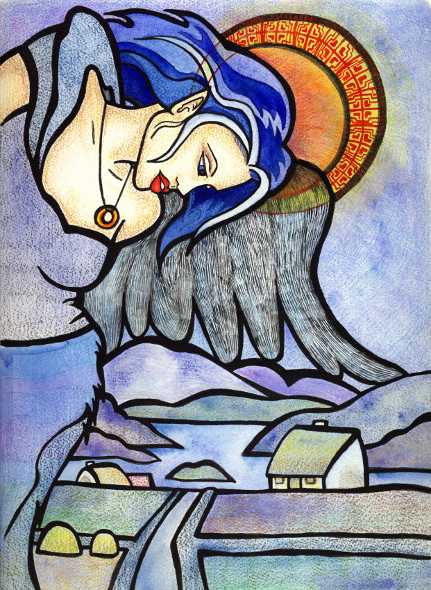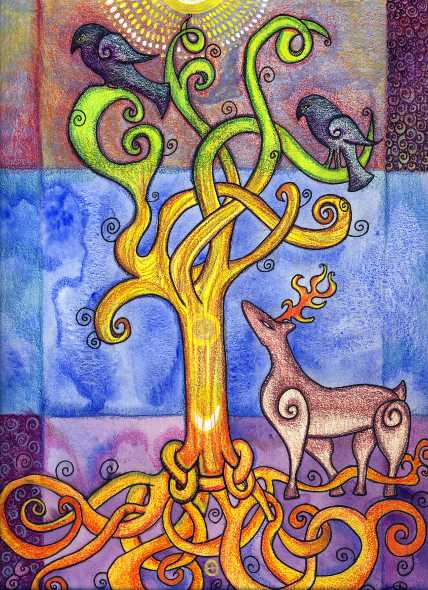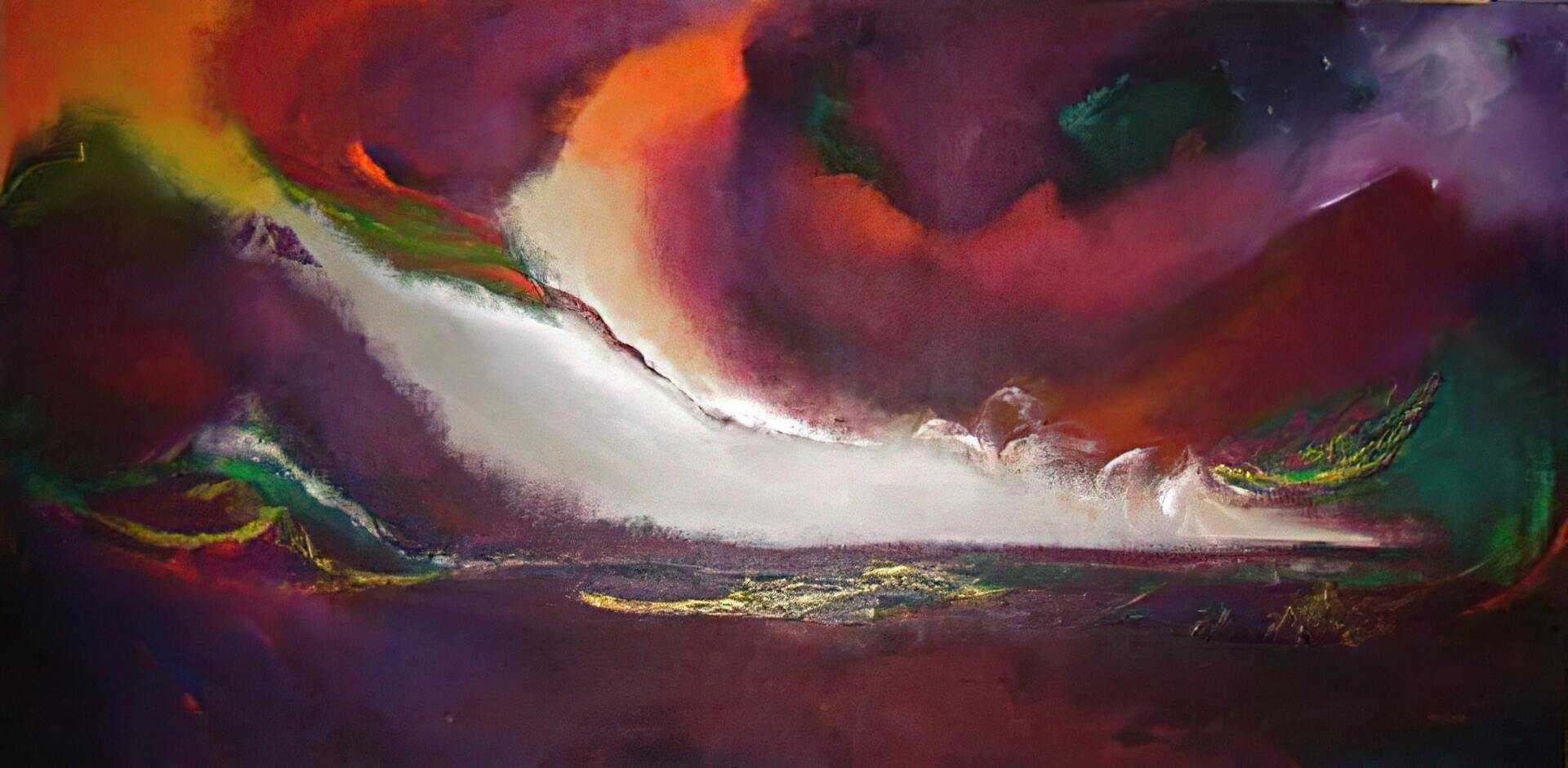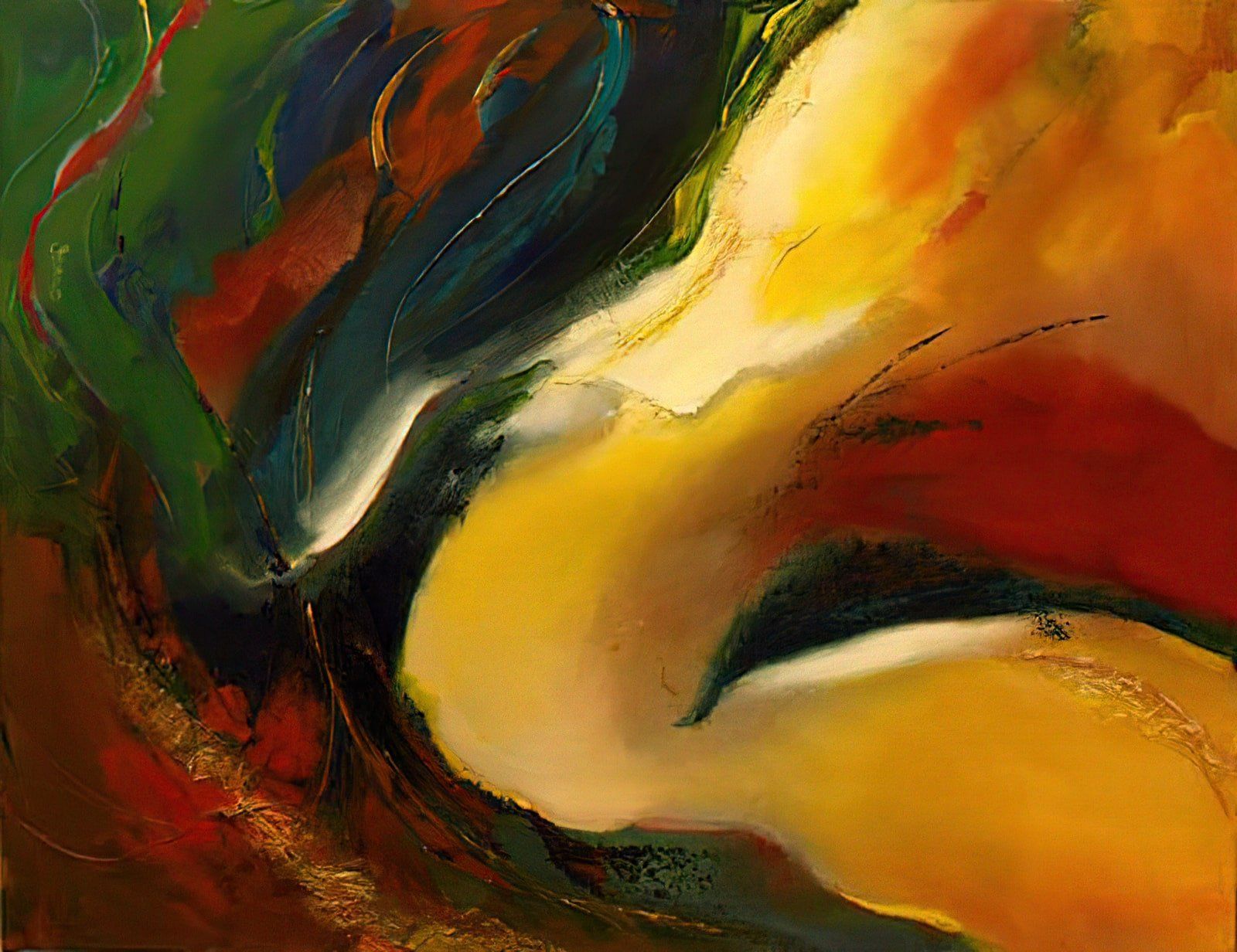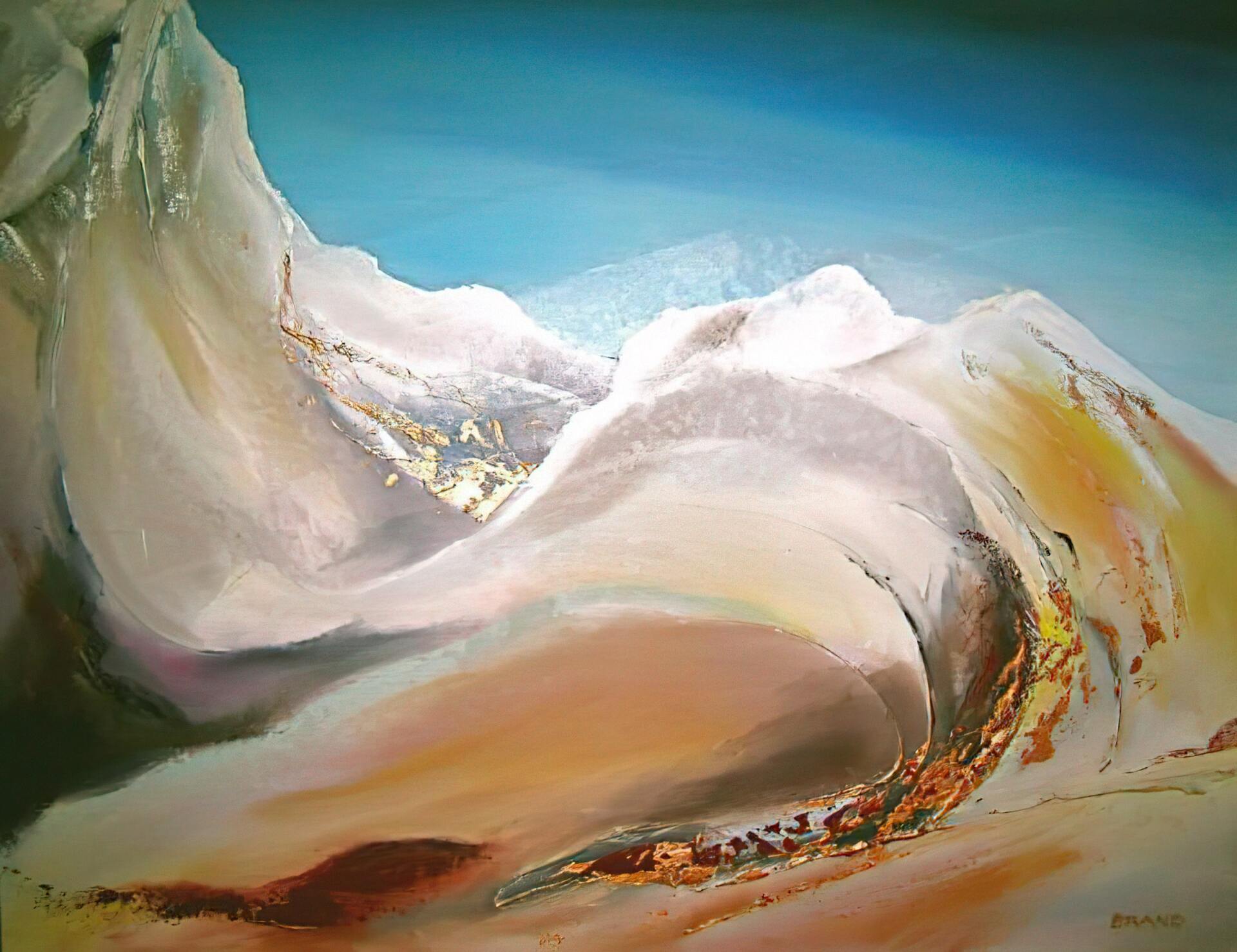Who and What are Shakti and Sophia?
Divine Feminine Sisters of Wisdom
Artwork by Susanne Iles
By Teri Degler
© 2009
In a number of specific Hindu texts and traditions Shakti is held to be the supreme divine cosmic force. In some cases she is pictured as a Goddess and given a name such as Tripura. In others she is called the Great Goddess or Great Mother. In yet others, she is seen as the cosmic feminine principle – a force that not only brings the universe into being but also propels it through time. Some individuals who revere Shakti see her as all of these. Regardless, in virtually all Hindu traditions she is held to be, at the very least, a feminine cosmic force that represents “power” or “energy”. In fact, the Sanskrit word shakti – or more properly śaki – is often translated as “power”.
By medieval times in India the idea that individual male Gods needed to possess a certain inherent female power in order to carry out creative activities – or even act at all – was becoming fairly widespread in Hindu mythology. According to the renowned scholar David Kinsley, this power came to be thought of as the God’s shakti1. A good example of this is found in the Shiva-Purāna in the quote, “Just as the moon does not shine without moonlight, so also Shiva does not shine without [the principle of] shakti”2. Often this principle was seen to be personified, or manifested, in the Goddess who was the God’s female counterpart. Thus, Krishna refers to Rādhā as his Shakti.
Shakti – The Divine Feminine Comes into Power
By the time the Devī-mahātmyā came into existence around the 6th century, the idea was beginning to spread that the all the individual Goddesses – the devīs – were manifestations of the one great Goddess3. This great Goddess was often known as Māhadevī. Eventually in some traditions all Goddesses – whether they were called Pārvatī, Durgā, Kālī, or any other name – came to be seen as a specific manifestation of this divine feminine cosmic force.
Nowhere is the reverence for the Great Goddess clearer than in the medieval writings known as the Tantras. Shakti does not just create the world, she is the world. She is the underlying essence of all creation, and all of creation – including the human body – is to be revered as being an expression of the divine. One idea that is expressed in these texts is that Shiva and Shakti represent, respectively, the macrocosmic masculine and feminine principles. As the masculine half of this bi-polar reality, Shiva is the principle of consciousness and is completely static. As his counterpart Shakti is the dynamic principle; she is the creative force that brings all the myriad aspects of creation into existence. She is also seen as the evolutionary energy that drives every aspect of creation along its evolutionary path – a path that leads ultimately to the dissolution of the multifaceted cosmos and its return to divine Oneness4.
The Tantras and Kundalini Shakti
In the Tantras and the traditions that have arisen out of them, the human being is often depicted as a microcosmic representation of this
Kundalini shakti and the chakra system are often symbolized by a tree
macrocosm. In this microcosm of the human body, the great cosmic Shakti takes on an individualized form where she is known as kundalini-shakti or simply kundalini. As such, she is generally held to be “sleeping” in or below the lowest chakra, mūlādhāra. Often the symbolic imagery used to depict kundalini-shakti in this state is a sleeping serpent that is coiled three-and-a-half times around the base of the spine. Kundalini-shakti is said to rest in this position until she is “awakened” by certain yogic practices. Ideally, she is then believed to travel upwards through the central nādī, or channel, that is known as the sushumā. On her upward journey she pierces the chakras. If she manages to reach the chakra at the crown of the head – known as sahasrāra – and is able to remains there, the yogi is said to attain Oneness with the Divine5.
Symbolically, kundalini-shakti’s goal on this upward journey is to reach the thousand petal lotus at the crown of the head where her Beloved, Shiva, waits for her. The Oneness she brings about in the individual when she reaches Shiva is a microcosmic reflection of what happens when Shakti reunites with Shiva in the macrocosm and succeeds in bringing all the various aspects of creation back to the One.
Shakti as the Creative Force
Regardless of exactly how Shakti is seen or depicted in various traditions, she is associated time and again with power, with creative force, and with the life force itself. One of the most beautiful
examples of this is found in Krishna-Janma-Khanda that is part of the Brahma-Vaivarta Purāna. In this particular section of this Purāna, Krishna is instructing Nanda, the king of the shepherds, about the nature of his Shakti, Rādhā. He says:
I bring about creation through Her, I create Brahma and the Devas through Her, the cosmos comes into being through Her, the world is released through Her, the world would be nothing without Her…. She is what burns in fire, She is the radiance of the moon, the coolness in water, the power which makes grain grow….She is the power of devotional love….She is the one who continually devotes herself to me in Bhakti…She is the power which allows the ocean of the world of appearances (Samsara) to be traversed. She is the Holy Wisdom of Those who are (the Holy Ones), She is presence of mind, She is the art of interpreting Sacred Scriptures, She is the power of giving in those who give….She is the life of everything. She is Krishna’s Beloved… in no way less than him. She rules over Krishna’s heart…She is the knowledge of the cosmos, its light and radiance and creative genius6…
For anyone who is familiar with various Hindu traditions this emphasis on the feminine and seeing it as powerful and/or divine is not surprising. What might be surprising, however, is the fact that a very similar tradition can be found in the Wisdom tradition of the Old Testament and in the writings of Christian mystics such as the 12th century Benedictine nun, Saint Hildegard von Bingen.
Sophia as The Divine Feminine and Creative Life Force
The divine feminine is often symbolized by a dancing woman -- in this picture you can see prana-shakti the life energy radiating through creation
The Wisdom tradition arises out of the many references to “Wisdom” that are found in certain Old Testament books such as Proverbs, Job, Ecclesiastes, Ecclesiasticus, and The Book of Wisdom7. In these passages Wisdom is clearly a being of some sort8. Because this being is so obviously feminine the Greek word for wisdom, Sophia, is often used to refer to her just as it was in the original Greek translations of the Hebrew texts9.
The similarities between Sophia and Shakti are quite astonishing. So much so, in fact, that some scholars believe they are simply two different cultural expressions of the same divine feminine cosmic force10. This resemblance between the two can be seen right from the beginning of Krishna’s description of his Shakti Rādhā: both of these feminine forces play essential roles in creation. Sophia’s is made clear in Proverbs where one verse proclaims, “The Lord by wisdom founded the earth…” Sophia herself then speaks out describing herself as a “master workman” who had a critical role in the process of creation:
The Lord created me at the
beginning of his work
the first of his acts of old…
When he established the heavens, I
was there,
when he drew a circle on the
face of the deep,
when he made firm the skies above…
when he marked the foundations
of the earth,
then I was beside him, like a
master workman,
and I was daily his delight…11
When Krishna says that the cosmos comes into being through his Shakti and that the world is released through her and would be nothing without her, it creates an image of vibrant cosmic energy. This image is emphasized when he says later that “she is the life of all things”. This same sense of cosmic energy is found in verses in the Book of Wisdom that describe Sophia as “the active cause of all things” and say that she “spans the world in power from end to end12.”
A stunning similarity between Shakti as the cosmic life essence in everything from fire and water to the glowing moon and the growing grain can be found in St. Hildegard von Bingen’s Sophia, an image of the divine feminine that came to her in her visions and spoke saying:
I, the fiery life of divine wisdom,
I ignite the beauty of the plains
I sparkle the waters,
I burn in the sun, and the moon, and the stars.
With wisdom I order all rightly….
I adorn all the earth.
I am the breeze that nurtures all things green….
I am the rain coming from the dew
that causes the grasses to laugh with the joy of life.
I call forth tears, the aroma of holy work.
I am the yearning for good.13
Shakit and Sophia — Bestowers of Divine Wisdom and Inspired Creativity
Sophia, like Shakti, is also the power which allows the ocean of the world of appearances to be broached and the true nature of reality to
be revealed. Solomon in describing his passionate desire for true knowledge says, “I called for help, and there came to me a spirit of wisdom.” God then gave him “a true understanding of the things as they are” and a “knowledge of the structure of the world and the operation of the elements”. Then he says, “I learned it all, hidden or manifest, for I was taught by wisdom, by her whose skill made all things14.”
Solomon is just one example of the “Holy Ones” who have received “Holy Wisdom” that Krishna’s Shakti bestows. The Book of Wisdom tells us that from time immemorial Sophia has been entering into “holy souls” and turning them into “friends of God” and “prophets”15. She is also, like Shakti, the art of interpreting Sacred Scriptures.
For example, the author of the biblical book Ecclesiasticus tell us that after he made a fervent prayer to understand the Lord’s teachings wisdom was sent to him. As soon as he began to listen to her, he says,
“…I was rewarded, and I gained for myself much instruction….I made progress in my studies; all glory to God who gives me wisdom…With her I gained understanding from the first…16”
Or, as Solomon says to God, “Who ever came to know your purposes, unless you had given him wisdom and sent your holy spirit from on high?17
Solomon also makes it clear that Sophia, like Krishna’s Shakti Rādhā, rules over the heart of her Beloved. He says, “Wisdom I loved; I sought her out when I was young and longed to win her for my bride; I was in love with her beauty” and “I loved her more than health and beauty; I preferred her to the light of day; for her radiance is unsleeping.” And the author of Ecclesiasticus agrees, saying, “From the first blossom to the ripening of the grape, she has been the delight of my heart18.’
Shakit and Sophia as the Radiant Light of the Cosmos
And there can be no question that Sophia and Shakti are both the radiance and light of cosmos:
“(Sophia) is the radiance that streams from everlasting light, the flawless mirror of the active power of God, and the image of his goodness.”
This beautiful verse is followed by the words:
She is but one, yet can do all things, herself unchanging, she makes all things new, age after age she enters into holy souls, and makes them friends of God and prophets,
for nothing is acceptable to God but the person who makes his home with wisdom.19”
In the Padma Purāna Krishna urges us to take refuge at the feet of his Shakti Rādhā, and says,
If you do find refuge with Her,
You will rule over me.
And since you took refuge
With Rādhā, my Beloved,
Remain everlastingly in my kingdom
Considering these two moving quotes, perhaps what these two traditions are trying to tell us is that what matters is not whether we make our home with Sophia or take refuge with the Shakti Rādhā but whether we recognize the importance of the cosmic divine feminine in our lives and in the life of the world.
_________________
Teri Degler is the author/co-author of ten books including The Fiery Muse: Creativity and the Spiritual Quest (Random House of Canada). Her latest book The Divine Feminine Fire: Creativity and Your Yearning to Express Your Self (Dreamriver Press, USA) has just been released. See www.teridegler.com
1. Kinsley, David. Hindu Goddesses: Visions of the Divine Feminine in the Hindu Religious Tradition. Berkeley: University of California Press, 1988, p. 49.
2. Feuerstein, Georg. The Encyclopedic Dictionary of Yoga. New York: Paragon, 1990, p. 322.
3. The Devī-mahātmyā is the first complete remaining text that features a Goddess as the primary deity. It is the story of Durgā’s victory over a terrifying monster.
4. Feuerstein, Georg. Tantra: The Path of Ecstasy. Boston: Shambhala, 1998, pp. 62-68.
It is important to point out that in the Tantric and the yogic traditions where this process is considered, the individual does not become one with the Divine, but rather realizes he or she has always been one with the Divine.
5. Schipflinger, Thomas. Sophia-Maria: A Holistic Vision of Creation. York Beach, Maine: Samuel Weiser, Inc., 1998, pp. 325-326. In all his references to Krishna and Rādhā , Schipflinger is quoting Walther Eidliz’s Die Indische Gottesliebe, Olten: Walter, 1955.
6. The books Proverbs, Job, and Ecclesiastes are found in both the Catholic and Protestant Bibles. The Book of Wisdom (also known as the Wisdom of Solomon) and Ecclesiasticus (also known as the Wisdom of Jesus Son of Sirach) are found in the Catholic Bible but only included in the Apocrypha of the Protestant Bible.
7. The nature of this being and her place in Christianity has been explored and debated since earliest times in Christian theology. This field of inquiry is known as sapiental theology.
8. The Hebrew word for Sophia is Chokmah which is also a feminine noun, and references to her as a feminine being appear in early Jewish gnostic traditions.
9. Schipflinger, Thomas. Sophia-Maria: A Holistic Vision of Creation. York Beach, Maine: Samuel Weiser, Inc., 1998, pp. 319-330.
10. Proverbs 3:19; 8: 21-30 in The Oxford Annotated Bible: Revised Standard Version. New York: Oxford University Press, 1962.
11. Wisdom 8: 5; 8:1.
12, Uhlein, Gabriel. Meditations with Hildegard of Bingen. Santa Fe: Bear & Co., 1982, pp. 30-31.
13. Wisdom 7: 7; 7:17, and 7:21-22.
14. Wisdom 7: 27.
15. Ecclesiasticus 51:16-17, 20.
16. Wisdom 8: 17.
17. Wisdom 8: 2, Wisdom 7:10; Ecclesiasticus 51: 15.
18. Wisdom 7: 26-28.
19. Schipflinger, Thomas. Sophia-Maria: A Holistic Vision of Creation. York Beach, Maine: Samuel Weiser, Inc., 1998, pp. 326-327.
Unless otherwise stated all Biblical quotes are from The Revised English Bible. London: Oxford University Press and Cambridge University Press, 1989.
Shakti and Sophia
Slowly, the hopelessness was beginning to win. As it did, I turned increasingly to my other great passion, researching the lives of mystics and the divine spiritual force that triggered their mystical experiences. Depending on the spiritual tradition these mystics came from, they gave this spiritual force names that ranged from Holy Spirit and Sophia to dumo fire, jeng chi, and kundalini-shakti. But I soon discovered that, regardless of what these great spiritual teachers called this force, what they experienced was astonishingly similar: From George Fox to St. Paul, they all described having visions of light, sensations of divine love, and an unshakable certainty that they were in some way united with the Divine.
Often they even described their experiences using remarkably similar imagery. Thus, the 12th century Christian visionary St. Hildegard of Bingen would describe an experience associated with the Holy Spirit saying, “…the heavens were opened and a blinding light of exceptional brilliance flowed through my entire brain. And so it kindled my whole heart and breast like a flame…” And Panchastavi, an 8th century yogi, would describe the awakening of kundalini-shakti as a light like a billion suns that glowed in “the crown of the head like the luminous white shine of the moon, and in the heart like the never setting splendorous sun…
About this time I had a mystical experience of my own that changed everything. Because so much of my research and focus had been on yoga and other Eastern traditions, I thought of it in terms of being a kundalini experience. Although it was nothing on the caliber of the experiences of the great mystics, it had a profound effect on me. It occurred one morning while I was attending a spiritual conference in California. Just before dawn broke, I had gone out onto the beach to do Tai Chi. With my eyes focused on the horizon, I began to move slowly through the set of positions. By the time I got to the flowing movement known as “Wave Hands Like Clouds”, something in my perception began to shift. The line separating sky and water began to dissolve. Sky and water became one, the water became one with the sand, and slowly all boundaries, all lines of demarcation dissolved. Suddenly, I could see, actually physically see, that all edges were illusion. Everything that had once appeared to be separate to me was in fact One – one vast, limitless expanse of pulsating life energy. Intense sensations began to rush through my body, and my heart exploded with love for this Oneness and everything it contained.
The Divine Feminine Fire
Somehow I managed to maintain my focus and finish the Tai Chi set. But there was so much of this light-filled energy moving through my body, I had to run. I began to jog along the narrow, sun-bleached board walk that wound through the grass above the dunes and up into the pines. Everything I saw, every rock and grain of sand, glowed with a radiant light. The green of the dune grass had become luminescent; the needles on the pine trees seemed to vibrate with a life of their own; the very air seemed to be filled with a life-giving force. This light, this radiance pulsed through every single thing I saw; it pulsed around me and through me. It was part of me; I was part of it, and I was part of everything.
This experience soon brought me to a crossroads in my life. I realized I could continue being an environmental writer and probably have some measure of financial security doing it. Or, once The Kitchen Handbook was finished, I could come out of the spiritual closet so to speak and write books about mystical experience. Once I did this, I knew that many people who were important to me – especially publishers, editors, and fellow writers – would no longer think of me as a serious writer; they’d see me as yet another new age flake.
Yet this was clearly the path I was going to have to follow. It seemed, ironically, that I was going to have to give up focusing directly on environmental issues to do the best work I could for the environment. Even though I believed, and still believe, the work environmental activists do is critically important, my “job” was going to be to write about spiritual experience and the transformation of consciousness – the transformation that allows individuals to see that we all One with each other, with all living beings, and with the earth itself.
This article originally appeared in the Religious Society of Friends’ publication What Canst Thou Say as “Consciousness and Creation”.
References
Flanagan, Sabina. Hildegard of Bingen: A Visionary Life. London and New York: Routledge, 1989.
Krishna, Gopi. Secrets of Kundalini in Panchastavi. New Delhi, India: Kundalini Research and Publication Trust, 1978.
Degler, Teri. The Divine Feminine Fire: Creativity and Your Yearning to Express Your Self, Pennsylvania: Dreamriver Press, 2010.


